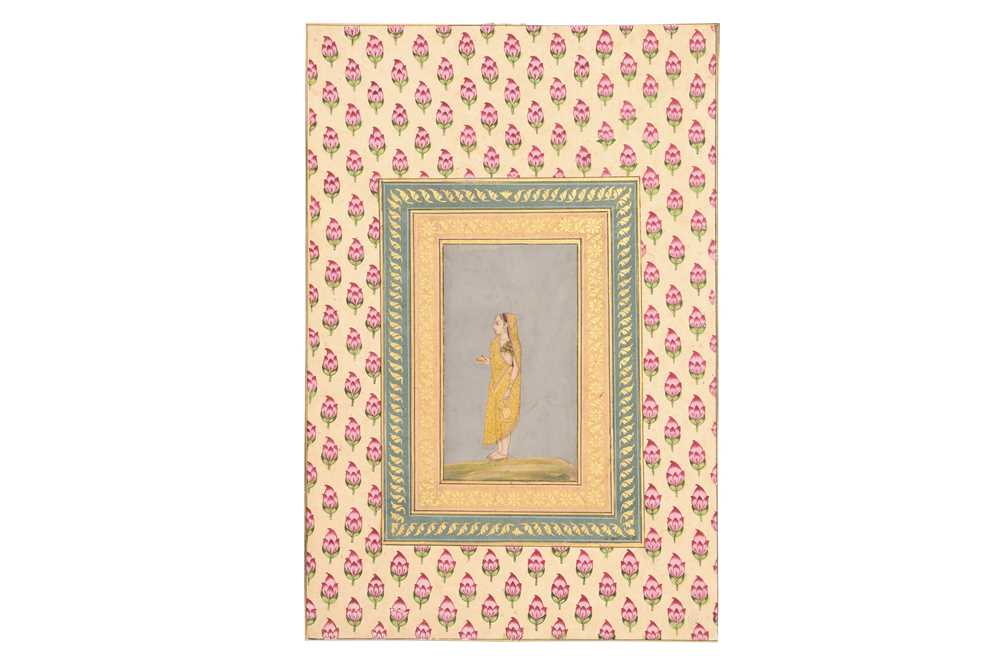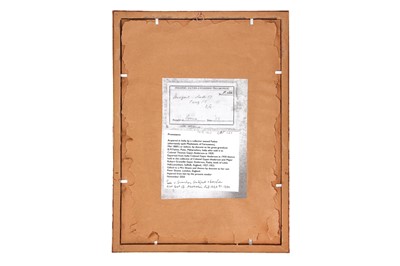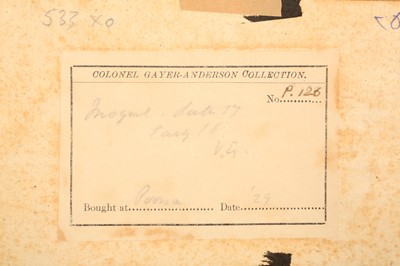29th Apr, 2022 13:00
Islamic & Indian Art
A STANDING PORTRAIT OF A FEMALE SHAIVITE DEVOTEE
Possibly Delhi, Mughal Northern India, ca. 1675 - 1720
A STANDING PORTRAIT OF A FEMALE SHAIVITE DEVOTEE
PROPERTY FROM THE COLONEL GAYER-ANDERSON COLLECTION
Possibly Delhi, Mughal Northern India, ca. 1675 - 1720
Opaque pigments heightened with gold on paper, the vertical portrait depicting a Hindu lady standing against a plain purplish-blue background, her forehead marked with the traditional Shaivite tripundra, three horizontal lines representing Lord Shiva’s threefold power of will (icchāśakti), knowledge (jñānaśakti), and action (kriyāśakti), wearing a gold-embroidered dark green choli top and ochre yellow sari with gold leaves pattern, holding a golden ceremonial water ewer in one hand, and a small circular container in the other, possibly filled with lime paste or other vegetal substances, her ankles, wrists and neck adorned with several typical Indian ornaments including gold bangles, multiple strings of pearl necklaces, and encrusted earrings and headband, the portrait set within black and gold rules, and concentric light pink and blue borders with rosette sprays and foliage, marked in black ink on the lower right corner GAP 126, the largest outer border polychrome-painted with a gridwork of pink lotus flower buds, on the verso of the painting a provenance label referring to Colonel Gayer-Anderson Collection, mounted, glazed and framed, on the back of the frame a black and white photocopy of the provenance reference on the verso of the painting reading Colonel Gayer-Anderson Collection Mogul, late 17th - early 18th, initialled V.G., bought at Pune, Date '29, no. 126, and a typed contextual note added by the present owner, the page 34.6cm x 23cm, 38.8cm x 28cm including the frame.
Provenance: Purchased by the present owner from Peter Sloane, London, England, in November 2020. Peter Sloane inherited it from his mother, Mrs. Sloane, who is reputed to have acquired it in a London auction during the 1950s.
This portrait of a Hindu female Shaivite devotee showcases a number of striking stylistic and content-related similarities with another portrait mounted on an album page border identical to ours, once part of the Colonel Gayer-Anderson Collection, and now in the permanent collection of the National Gallery of Australia (acc. no. 91.1370, URL: https://searchthecollection.nga.gov.au/object?uniqueId=157062). This museum holds in its collection a total of three analogous paintings, the earliest dating 1675 and the latest ca. 1800, all depicting Indian ladies in a Mughal style; each one is mounted on a polychrome-painted album page floral border. These paintings present the same credit line, The Gayer-Anderson Gift 1954, and they are all marked in black ink on the lower right corner with the initials GAP and a numeral. The connection with the album page previously mentioned is not only visual: the inventory numbers suggest this and our painting were once part of the same album and most importantly, they were placed next to each other as a pair. Indeed, our lot is marked GAP 126, whilst the one in the National Gallery of Australia presents the previous number, GAP 125.
Thomas Gayer-Anderson (1881 - 1960) and Robert Greville-Anderson (1881 - 1945) were identical twin brothers, born in Ireland on 29 July 1881, sons of Robert Henry Anderson and his wife Mary née Morgan. Both enrolled in the military career and involved in a number of operations that led them to travel to South Africa, Italy, Egypt, and India, the two brothers are renowned in the field of Islamic and Indian art studies for their fondness of the local decorative arts and their outstanding collection, featuring prominently miniatures and paintings, and several other artworks from different regions of India and Egypt. Before retiring, Thomas Gayer-Anderson, a keen draughtsman himself, spent three years in India (1926 - 1929), in which he amassed a very large collection of paintings. One of his main sources was an Indian collector named Fadnis, based in Pune, Maharashtra. The photocopied inventory reference at the back of our lot suggests the painting was bought there in 1929.
A number of pieces of the now-dispersed Thomas Gayer-Anderson collection were donated to different international institutions in the 1950s, including the National Gallery of Australia, museums in Cairo, the Fitzwilliam Museum in Cambridge, and the British Museum and the Victoria & Albert Museum in London.
Sold for £3,250
Includes Buyer's Premium
Do you have an item similar to the item above? If so please click the link below to submit a free online valuation request through our website.





